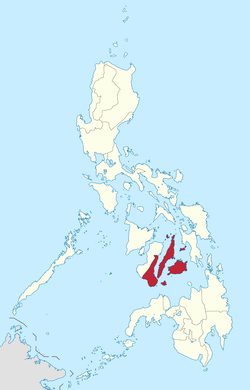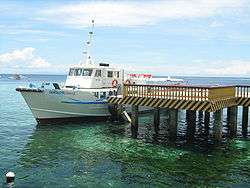Central Visayas
| Central Visayas Region VII | ||||||
|---|---|---|---|---|---|---|
| Region | ||||||
From top, left to right: Cebu Metropolitan Cathedral; Chocolate Hills in Bohol; Salagdoong Beach in Siquijor; Balinsasayao Twin Lakes Natural Park in Negros Oriental | ||||||
 Location in the Philippines | ||||||
| Coordinates: 10°00′N 123°30′E / 10°N 123.5°ECoordinates: 10°00′N 123°30′E / 10°N 123.5°E | ||||||
| Country | Philippines | |||||
| Island group | Visayas | |||||
| Regional center | Cebu City | |||||
| Area | ||||||
| • Total | 10,500.44 km2 (4,054.24 sq mi) | |||||
| Population (2015 census)[1] | ||||||
| • Total | 6,041,903 | |||||
| • Density | 580/km2 (1,500/sq mi) | |||||
| Time zone | PST (UTC+8) | |||||
| ISO 3166 code | PH-07 | |||||
| Provinces | ||||||
| Cities | ||||||
| Municipalities | 97 | |||||
| Barangays | 2,446 | |||||
| Cong. districts | 11 | |||||
| Languages | ||||||
Central Visayas (Cebuano: Tunga-tungang Kabisay-an; Filipino: Gitnang Kabisayaan) is a region of the Philippines, designated as Region VII. It is located in the central part of the Visayas island group, and consists of three island provinces: Cebu, Bohol and Siquijor; one province from Negros island: Negros Oriental; and three highly urbanized cities: Cebu City, Lapu-Lapu, and Mandaue. Cebu City is the regional center. The region is dominated by the native speakers of Cebuano. The land area of the region is 10,500.44 km2 (4,054.24 sq mi), and with a population of 6,041,903 inhabitants, it is the most populous region in the Visayas.
On May 29, 2015, the region was redefined, when Region VII lost the province of Negros Oriental to the newly formed Negros Island Region, However the region was dissolved and the province was returned to Region VII on August 7, 2017
History
Regions first came into existence on September 24 of 1972, when the provinces of the Philippines were organized into 11 regions by Presidential Decree No. 1 as part of the Integrated Reorganization Plan by President Ferdinand Marcos. The provinces of Cebu, Bohol and Negros Oriental (including its then-subprovince of Siquijor) were grouped together to form the Central Visayas region.
By virtue of Executive Order No. 183 issued on May 29 of 2015, by President Benigno Aquino III, the province of Negros Oriental was removed from Central Visayas to form the Negros Island Region along with Negros Occidental and its provincial capital, Bacolod City.[2] But later regained Negros Oriental and its capital, Dumaguete City back into Central Visayas on August 9, 2017 when President Rodrigo Duterte dissolved the Negros Island Region, revoking Executive Order No. 183, s. 2015 through the signage of Executive Order No. 38, citing the reason of the lack of funds to fully establish the NIR according to Benjamin Diokno, the Secretary of Budget and Management.[3]
Demographics
| Population census of Central Visayas | ||
|---|---|---|
| Year | Pop. | ±% p.a. |
| 1990 | 3,668,852 | — |
| 2000 | 4,576,865 | +2.24% |
| 2010 | 5,513,514 | +1.88% |
| 2015 | 6,041,903 | +1.76% |
| Data in 2015 excludes Negros Oriental. Source: National Statistics Office[1][4][5][6] | ||
In the 2013 electoral roll, it had 4,114,046 registered voters, meaning that 68% of the population are aged 18 and over.[7]
According to the 2015 census, it had a population of 6,041,903. The population density was 580/km2 (1,500/sq mi). The 2015 census showed an average annual population growth rate of 1.76% from 2010 to 2015, slightly higher than the national average of 1.72%.[1]
Languages
The native languages of Central Visayas are:
- Bantayanon, spoken in Bantayan Island in Cebu.
- Boholano, spoken in Bohol.
- Cebuano, spoken in Negros Oriental, Cebu, Siquijor, and Bohol. It is the regional lingua franca.
- Hiligaynon, spoken in western Negros Oriental.
- Porohanon, spoken in Camotes Islands in Cebu.
Administrative divisions
The Central Visayas region consists of 4 provinces and 3 independent cities:

| Province or HUC | Capital | Population (2015)[1] | Area[8] | Density | Cities | Muni. | Brgy. | |||||
|---|---|---|---|---|---|---|---|---|---|---|---|---|
| km2 | sq mi | /km2 | /sq mi | |||||||||
| Bohol | Tagbilaran | 21.7% | 1,313,560 | 4,820.95 | 1,861.38 | 270 | 700 | 1 | 47 | 1,109 | ||
| Cebu | Cebu City | 48.6% | 2,938,982 | 4,943.72 | 1,908.78 | 590 | 1,500 | 6 | 44 | 1,066 | ||
| Negros Oriental | Dumaguete | 30.7% | 1,354,995 | 5,385.53 | 2,079.36 | 250 | 650 | 6 | 19 | 557 | ||
| Siquijor | Siquijor | 1.6% | 95,984 | 337.49 | 130.31 | 280 | 730 | 0 | 6 | 134 | ||
| Cebu City | † | — | 15.3% | 922,611 | 315.00 | 121.62 | 2,900 | 7,500 | — | — | 80 | |
| Lapu-Lapu | † | — | 6.8% | 408,112 | 58.10 | 22.43 | 7,000 | 18,000 | — | — | 30 | |
| Mandaue | † | — | 6.0% | 362,654 | 25.18 | 9.72 | 14,400 | 37,000 | — | — | 27 | |
| Total | 7,396,898 | 15,885.97 | 6,133.61 | 470 | 1,200 | 10 | 116 | 3,003 | ||||
|
† Cebu City, Mandaue and Lapu-Lapu are highly urbanized cities, figures are excluded from Cebu province. | ||||||||||||
| City | Population (2015)[1] | Area | Density | City class | Income class | Province | ||
|---|---|---|---|---|---|---|---|---|
| km2 | sq mi | /km2 | /sq mi | |||||
| Bogo | 78,120 | 103.52 | 39.97 | 750 | 1,900 | Component | 6th | Cebu |
| Carcar | 119,664 | 116.78 | 45.09 | 1,000 | 2,600 | Component | 5th | Cebu |
| Cebu City | 922,611 | 315.00 | 121.62 | 2,900 | 7,500 | Highly urbanized | 1st | Cebu |
| Danao | 136,471 | 107.30 | 41.43 | 1,300 | 3,400 | Component | 3rd | Cebu |
| Lapu-Lapu | 408,112 | 58.10 | 22.43 | 7,000 | 18,000 | Highly urbanized | 1st | Cebu |
| Mandaue | 362,654 | 25.18 | 9.72 | 14,000 | 36,000 | Highly urbanized | 1st | Cebu |
| Naga | 115,750 | 101.97 | 39.37 | 1,100 | 2,800 | Component | 3rd | Cebu |
| Tagbilaran | 105,051 | 36.50 | 14.09 | 2,900 | 7,500 | Component | 3rd | Bohol |
| Talisay | 227,645 | 39.87 | 15.39 | 5,900 | 15,000 | Component | 3rd | Cebu |
| Toledo | 170,335 | 216.28 | 83.51 | 790 | 2,000 | Component | 3rd | Cebu |
Media
Cebu City is the main media hub for both the region. Large media networks – ABS-CBN, GMA Network, TV5, People's Television Network and CNN Philippines – maintain their respective local stations and branches for viewership, commercial and news coverage purposes. Most of these stations broadcast local news and public affairs as well as entertainment and dramas to cater the local viewers.
Aside from the 24 national daily newspapers available, Cebu City also has 20 local newspapers. Among the widely read are the Sun Star Cebu. The country's main Islamic news journal, The Voice of Islam, was founded in 1961 and published in this city.
Transportation
Ports
The Port of Cebu is the region's main gateway. There are also ports in Tagbilaran in Bohol and Larena in Siquijor. Inter-island shipping is served by numerous shipping lines, two of them fastcraft companies which serve all the provinces in the region.
Airports
The Mactan-Cebu International Airport, located in Lapu-Lapu City, is the country's second busiest airport (after Ninoy Aquino International Airport in Metro Manila) and the only airport in the Visayas serving international flights (aside from Kalibo International Airport). It is the primary airline hub of Cebu Pacific, and secondary hub for Philippine Airlines and its subsidiaries, with flights to locations throughout the country. It also serves international flights to other Asian and intercontinental destinations.[9]
Other airports in the region are Tagbilaran Airport, serves Tagbilaran and Bohol with flights to Manila.
References
- 1 2 3 4 5 Census of Population (2015). "Region VII (Central Visayas)". Total Population by Province, City, Municipality and Barangay. PSA. Retrieved 20 June 2016.
- ↑ "Executive Order No. 183, s. 2015". Official Gazette (Philippines). May 29, 2015. Retrieved June 5, 2015.
- ↑ "Duterte dissolves Negros Island Region". Rappler. August 9, 2017. Retrieved August 10, 2017.
- ↑ Census of Population and Housing (2010). Population and Annual Growth Rates for The Philippines and Its Regions, Provinces, and Highly Urbanized Cities (PDF). NSO. Retrieved 29 June 2016.
- ↑ Census of Population and Housing (2010). "Region VII (Central Visayas)". Total Population by Province, City, Municipality and Barangay. NSO. Retrieved 29 June 2016.
- ↑ Census of Population (1995, 2000 and 2007). "Region VII (Central Visayas)". Total Population by Province, City and Municipality. NSO. Archived from the original on 24 June 2011.
- ↑ "2016 National and Local Elections Statistics". Commission on Elections. 2016.
- ↑ "PSGC Interactive; List of Provinces". Philippine Statistics Authority. Archived from the original on 21 January 2013. Retrieved 4 April 2016.
- ↑ "Mactan Cebu International Airport - Cebu Pacific - Philippines". Mactan-cebuairport.com.ph. Retrieved 2013-04-22.
External links
 Media related to Central Visayas at Wikimedia Commons
Media related to Central Visayas at Wikimedia Commons Central Visayas travel guide from Wikivoyage
Central Visayas travel guide from Wikivoyage






